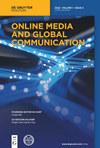YouTube和TikTok作为学习他人的平台:以上海迪士尼乐园的非中国旅游视频为例
引用次数: 2
摘要
摘要目的由于现有的迪士尼粉丝和在线旅行证件的日益流行,有机会研究品牌国际化、在线视频文化和粉丝。存在的问题是,基于视频的社交媒体是否允许对文化他人进行更人性化的表达,以及内容主题在多大程度上塑造了表达。方法在本研究中,将归纳定性方法应用于顶级YouTube旅游视频和TikTok,分析上海迪士尼乐园的非中国游客如何代表他们的体验并调节文化差异。发现视频经常展示公园技术先进的景点,在评论中令人敬畏和嫉妒。少数视频讨论了中国客人的行为,并将其标记为非规范性的,与迪士尼预期的客人行为不同。然而,在YouTube和TikTok上,从子类型、评论、凝视和与品牌的亲近度来看,表现方式存在差异。实际意义进入中国市场的品牌也必须意识到,在忠诚的非中国在线粉丝中,他们的住宿是如何出现的。这项研究表明,反复出现的旅行写作比喻如何影响在线旅行媒体,这也塑造了人们对中国的看法,并通过平台激励争议和采样不同文化来加强。社会含义技术敬畏和对客人行为的批评是由迪士尼粉丝文化构成的,其中包括由于品牌与身份密切相关而对品牌的占有欲保护。这些元素在YouTube和TikTok平台上的表现略有不同。YouTube上的热门视频往往以向外聚焦的凝视为特色,无论是无实体的穿越还是文化“教育”。顶级TikTok将目光转向内部,专注于体验。价值这项研究对比了YouTube和TikTok两个主要平台对上海迪士尼乐园的调解。对同一主题的平台使用进行对比的研究很少,重点领域也是如此。这项研究表明了在同一主题上比较平台的有用性。本文章由计算机程序翻译,如有差异,请以英文原文为准。
YouTube and TikTok as Platforms for Learning about Others: The Case of Non-Chinese Travel Videos in Shanghai Disneyland
Abstract Purpose Due to existing Disney fandom and the increased popularity of online travel documentation, there is an opportunity to study brand internationalization, online video culture, and fandom. There are questions of whether video based social media allows for more humane representations of cultural others and to what extent the topic of content shapes representation. Methodology In this study, an inductive qualitative method is applied to top YouTube travel videos and TikToks to analyze how non-Chinese visitors to Shanghai Disneyland represent their experience and mediate cultural difference. Findings Videos often exhibit the technologically advanced attractions of the park, inspiring awe and envy in comments. A minority of videos discuss the behavior of Chinese guests and mark them as non-normative and different from expected Disney guest behavior. However, there are differences in representation on YouTube and TikTok from sub-genres, comments, gazes, and closeness to brand. Practical implications Brands entering the Chinese market must also be aware of how their accommodations appear to loyal non-Chinese online fandoms. This study shows how reoccurring tropes of travel writing influence online travel media, which also shapes perceptions of China, and is reinforced by platform incentives for controversy and sampling diverse cultures. Social implications Technological awe and critiques of guest behavior are structured by Disney fan culture, which includes a possessive protectiveness over the brand due to its close association with identity. These elements play out slightly differently on the platforms of YouTube and TikTok. Top YouTube videos tend to feature outward-focusing gazes, whether they are disembodied ride-throughs or cultural “education.” Top TikToks turn the gaze inward and focus on experience. Value This study contrasts use of two major platforms, YouTube and TikTok, to examine mediation of Shanghai Disneyland. Studies contrasting platform use of the same topic are rare, as is the area of focus. This study shows the usefulness of comparing platforms on the same topic.
求助全文
通过发布文献求助,成功后即可免费获取论文全文。
去求助
来源期刊

Online Media and Global Communication
Communication, Media Studies, Internet Studies, International Studies, International Relations-
自引率
0.00%
发文量
0
期刊介绍:
Online Media and Global Communication (OMGC) is a new venue for high quality articles on theories and methods about the role of online media in global communication. This journal is sponsored by the Center for Global Public Opinion Research of China and School of Journalism and Communication, Shanghai International Studies University, China. It is published solely online in English. The journal aims to serve as an academic bridge in the research of online media and global communication between the dominating English-speaking world and the non-English speaking world that has remained mostly invisible due to language barriers. Through its structured abstracts for all research articles and uniform keyword system in the United Nations’ official six languages plus Japanese and German (Arabic, Chinese, English, French, Russian, Spanish, Japanese, and German), the journal provides a highly accessible platform to users worldwide. Its unique dual track single-blind and double-blind review system facilitates manuscript reviews with different levels of author identities. OMGC publishes review essays on the state-of-the-art in online media and global communication research in different countries and regions, original research papers on topics related online media and global communication and translated articles from non-English speaking Global South. It strives to be a leading platform for scientific exchange in online media and global communication.
For events and more, consider following us on Twitter at https://twitter.com/OMGCJOURNAL.
Topics
OMGC publishes high quality, innovative and original research on global communication especially in the use of global online media platforms such as Facebook, TikTok, YouTube, Twitter, Instagram, WhatsApp, Weibo, WeChat, Wikipedia, web sites, blogs, etc. This journal will address the contemporary concerns about the effects and operations of global digital media platforms on international relations, international public opinion, fake news and propaganda dissemination, diaspora communication, consumer behavior as well as the balance of voices in the world. Comparative research across countries are particularly welcome. Empirical research is preferred over conceptual papers.
Article Formats
In addition to the standard research article format, the Journal includes the following formats:
● One translation paper selected from Non-English Journals that with high quality as “Gems from the Global South” per issue
● One review essay on current state of research in online media and global communication in a country or region
 求助内容:
求助内容: 应助结果提醒方式:
应助结果提醒方式:


